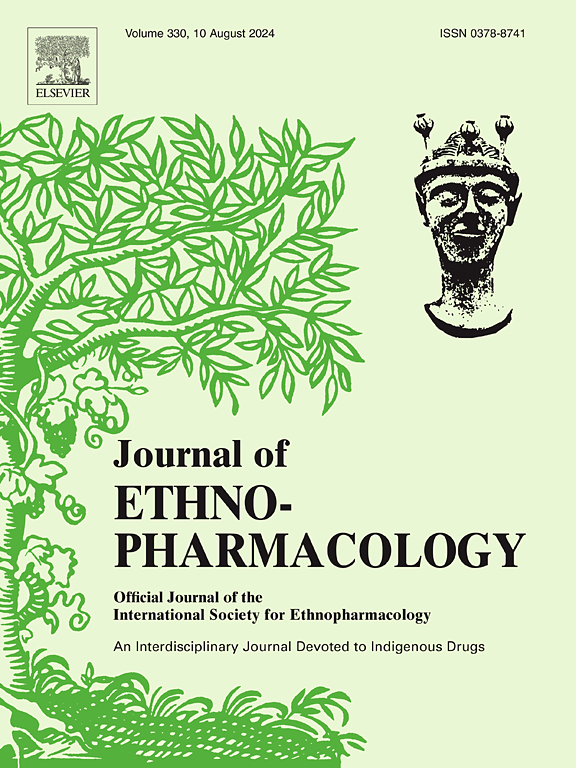Revealing the molecular mechanism of Buzhong Yiqi Decoction for tendon bone healing on the basis of network pharmacology, molecular docking and experimental validation
IF 4.8
2区 医学
Q1 CHEMISTRY, MEDICINAL
引用次数: 0
Abstract
Ethnopharmacological relevance
Buzhong Yiqi Decoction (BD), a traditional formula in Chinese medicine, is clinically and historically recognized for its effectiveness in reducing physical fatigue and promoting strength, as well as enhancing bone remodeling. Nevertheless, its specific molecular mechanisms related to bone formation have yet to be thoroughly characterized.
Aim of the study
This study aims to investigate the effects and mechanisms of BD on osteogenesis in bone marrow mesenchymal stem cells and in a model of tendon-bone junction injury in mice.
Materials and methods
By establishing a mouse model of tendon-bone junction injury, the pathological morphology of the tendon-bone junction in mice was observed. Determining the mechanism of action of BD in regulating osteogenic differentiation through network pharmacology and molecular docking. Flow analysis and osteogenic induction assay were utilized to verify the effect of BD in promoting BMSCs osteogenic differentiation in vitro. In vivo experiments were performed to validate the impact of BD in improving healing after tendon-bone junction injury in mice by promoting osteogenic differentiation.
Results
Bone loss at the heel bone end is an essential pathophysiologic process in the natural healing process after injury to the tendon-bone junction. Using network pharmacology and molecular docking, we identified the PI3K-Akt signaling pathway as a critical mediator of BD-induced osteogenic differentiation. In vitro experiments demonstrated that BD promoted BMSC osteogenesis, while in vivo assays confirmed the enhancement of tendon-bone healing in mice models.
Conclusion
These results suggest that BD can effectively promote tendon-bone repair, with the PI3K-Akt pathway playing a crucial role in its therapeutic effects, positioning BD as a promising candidate for improving musculoskeletal injury recovery.

基于网络药理学、分子对接和实验验证,揭示补中益气汤促进肌腱骨愈合的分子机制。
民族药理学相关性:补中益气汤(BD)是一种传统中药方剂,在临床上和历史上都被认为具有减轻身体疲劳、增强力量、促进骨骼重塑的功效。然而,其与骨形成相关的具体分子机制尚未被彻底表征。研究目的:本研究旨在探讨双酚d对小鼠骨髓间充质干细胞成骨的影响及机制。材料与方法:通过建立小鼠肌腱-骨交界处损伤模型,观察小鼠肌腱-骨交界处的病理形态。通过网络药理学和分子对接研究BD调控成骨分化的作用机制。采用流量分析和成骨诱导实验验证BD对BMSCs体外成骨分化的促进作用。通过体内实验验证BD通过促进成骨分化促进小鼠肌腱-骨交界处损伤愈合的作用。结果:足跟骨端骨丢失是肌腱-骨连接处损伤自然愈合过程中必不可少的病理生理过程。通过网络药理学和分子对接,我们发现PI3K-Akt信号通路是bd诱导成骨分化的关键介质。体外实验表明,BD促进BMSC成骨,而体内实验证实了小鼠模型中肌腱-骨愈合的增强。结论:上述结果表明,BD可有效促进肌腱-骨修复,其中PI3K-Akt通路在其治疗效果中起着至关重要的作用,BD有望成为改善肌肉骨骼损伤恢复的候选药物。
本文章由计算机程序翻译,如有差异,请以英文原文为准。
求助全文
约1分钟内获得全文
求助全文
来源期刊

Journal of ethnopharmacology
医学-全科医学与补充医学
CiteScore
10.30
自引率
5.60%
发文量
967
审稿时长
77 days
期刊介绍:
The Journal of Ethnopharmacology is dedicated to the exchange of information and understandings about people''s use of plants, fungi, animals, microorganisms and minerals and their biological and pharmacological effects based on the principles established through international conventions. Early people confronted with illness and disease, discovered a wealth of useful therapeutic agents in the plant and animal kingdoms. The empirical knowledge of these medicinal substances and their toxic potential was passed on by oral tradition and sometimes recorded in herbals and other texts on materia medica. Many valuable drugs of today (e.g., atropine, ephedrine, tubocurarine, digoxin, reserpine) came into use through the study of indigenous remedies. Chemists continue to use plant-derived drugs (e.g., morphine, taxol, physostigmine, quinidine, emetine) as prototypes in their attempts to develop more effective and less toxic medicinals.
 求助内容:
求助内容: 应助结果提醒方式:
应助结果提醒方式:


